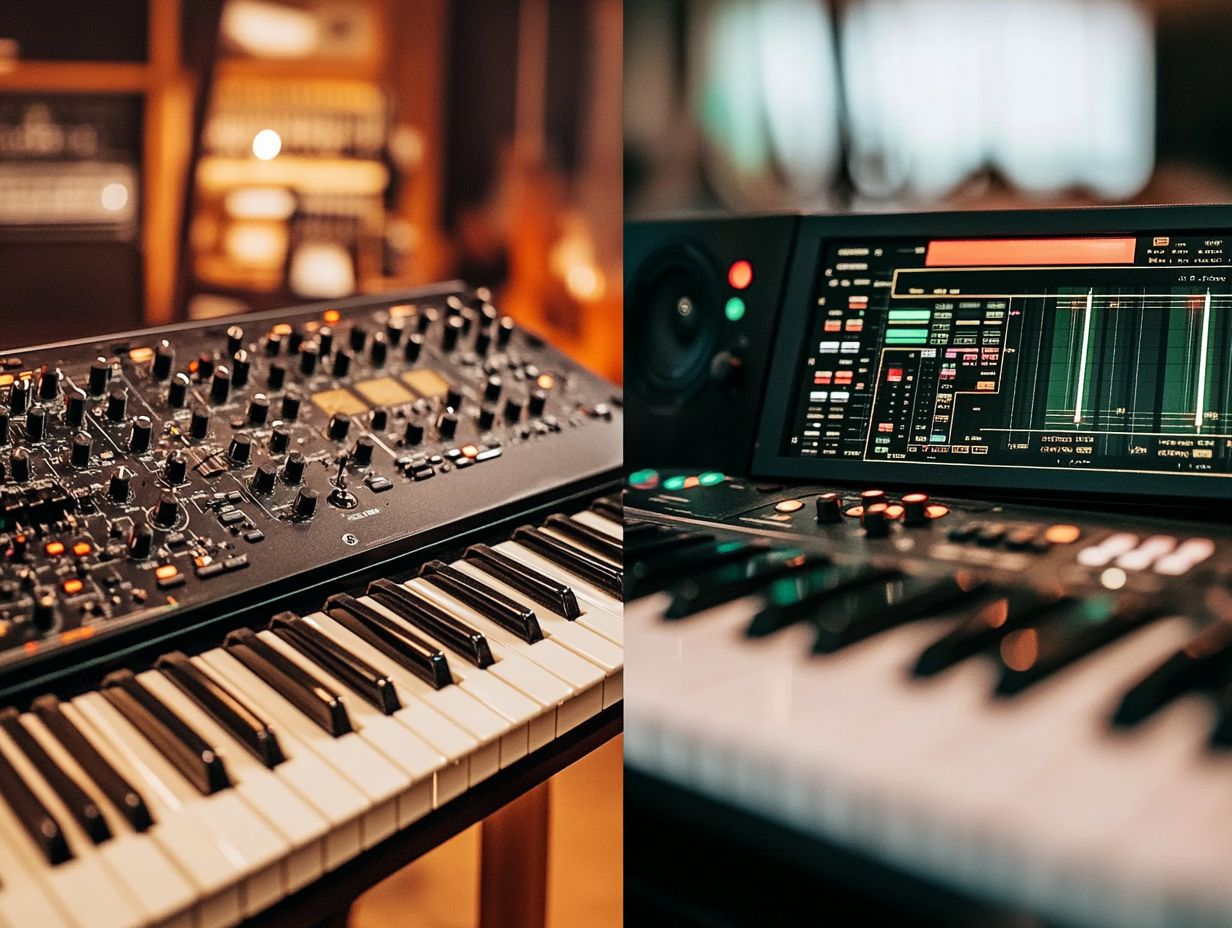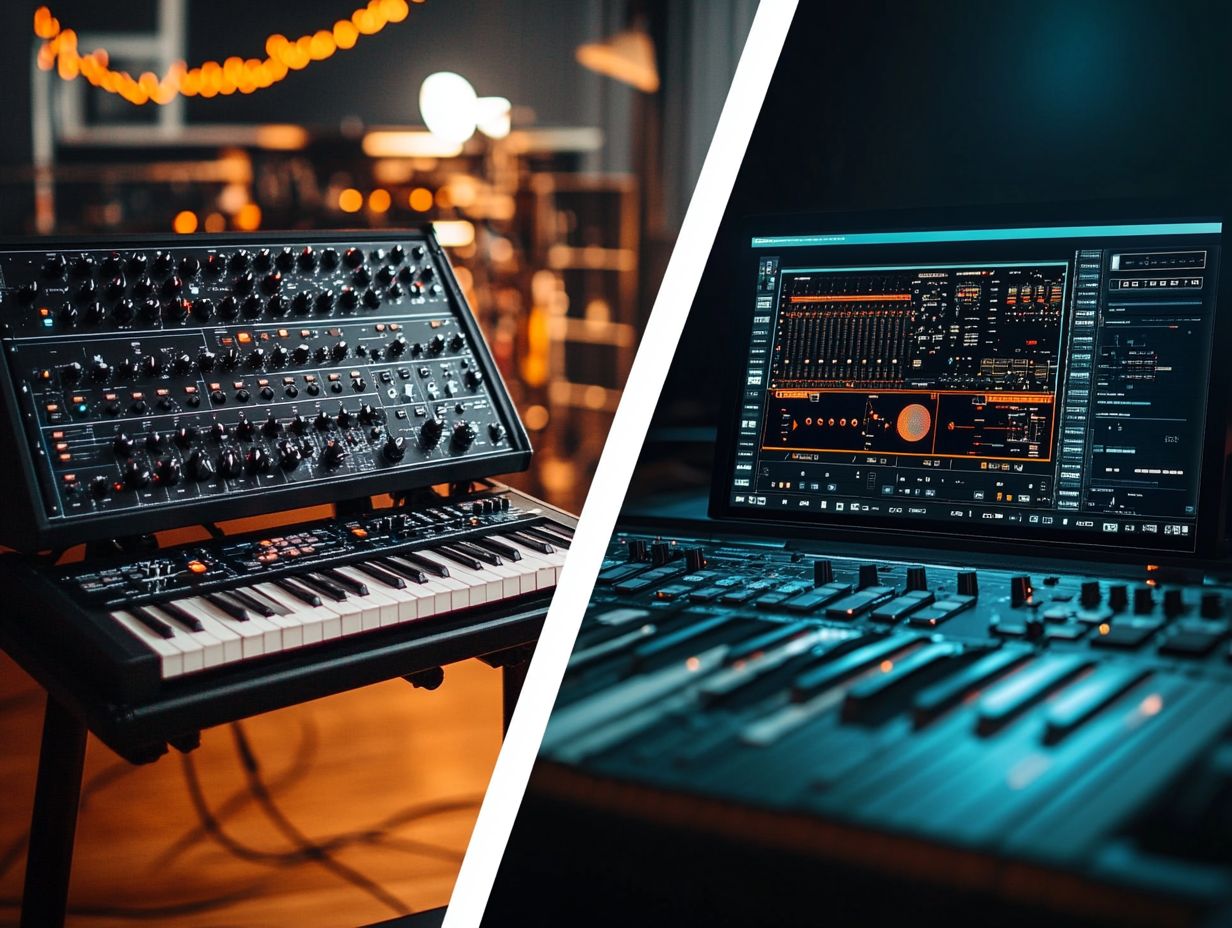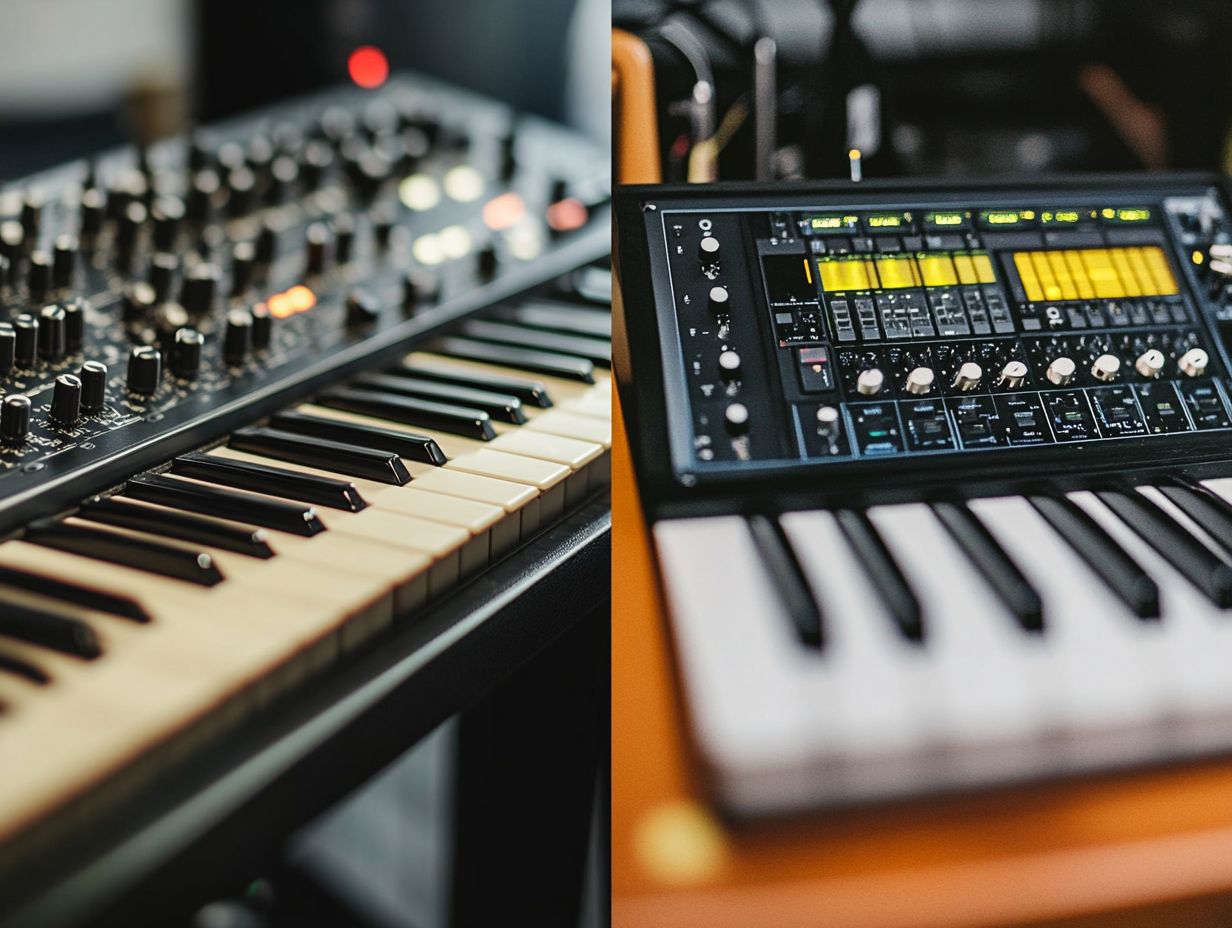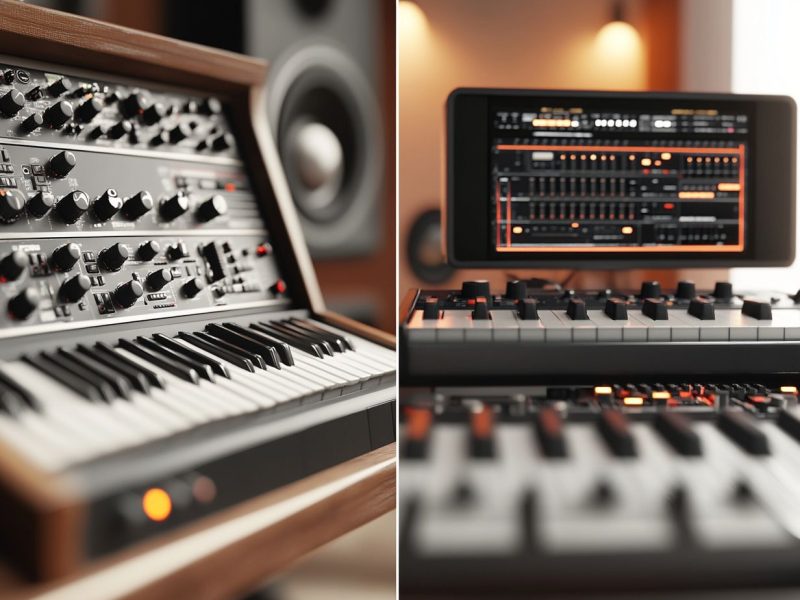Synthesizers have significantly transformed the music landscape, providing vast opportunities for sound exploration. This article delves into the intriguing domain of synthesizers, beginning with an examination of analog synthesizers and the distinctive characteristics that shape their sound.
Following this, digital synthesizers will be analyzed, emphasizing their contemporary capabilities. A comparative analysis will highlight the strengths and weaknesses of both categories, addressing aspects such as sound quality, flexibility, cost, and accessibility.
Additionally, practical recommendations will be offered to assist individuals in selecting the appropriate synthesizer that aligns with their musical requirements.
What are Synthesizers?

Synthesizers are electronic instruments that generate a wide range of sounds through various methods of sound synthesis, making them vital tools in contemporary music production, particularly in the field of electronic music.
These instruments utilize diverse functionalities, including additive, subtractive, and granular synthesis, to create intricate soundscapes that resonate with audiences. With their capability to modulate pitch, filter frequencies, and apply effects through advanced electronic circuits, synthesizers offer exceptional flexibility in audio processing.
Musicians can layer sounds, develop rhythmic sequences, and incorporate dynamic modulation, thereby transforming basic waveforms into complex auditory experiences. Their significance extends beyond electronic genres; synthesizers are integrated into various musical styles, enriching the landscape of modern music technology.
As new software synthesizers continue to emerge, the possibilities for sound exploration are constantly expanding, enabling artists to push the boundaries of creativity.
Analog Synthesizers
Analog synthesizers are highly esteemed for their capacity to generate rich, warm sounds through the application of analog circuitry, which manipulates voltage to create oscillations and produce sound waves.
These synthesizers employ components such as oscillators, filters, and modulation techniques to shape audio signals, resulting in a tactile and organic sound that many musicians and producers find appealing.
Originating from the early days of electronic music, vintage analog synthesizers continue to exert a significant influence on modern sound design, providing unique timbres that are challenging to replicate using digital technology.
How They Work and Their Characteristics
Analog synthesizers generate sound through oscillators, which create waveforms that can be shaped and filtered to produce a wide array of sounds. By employing various synthesis techniques, such as subtractive synthesis, these synthesizers can modify frequency, amplitude, and waveform to yield distinct audio textures.
This intricate process commences with oscillators, which serve as the primary sound source, generating fundamental waveforms such as sine, square, and sawtooth. Following the generation of these waveforms, filters are utilized to sculpt the timbre of the sound, allowing for further manipulation through the attenuation or enhancement of specific frequencies.
In addition, modulation techniques that employ low-frequency oscillators (LFOs) and envelopes introduce variation and complexity, transforming a static sound into a more dynamic and expressive entity. For example, the filter envelope can precisely dictate the evolution of a sound over time, influencing its tonal characteristics and sustain.
This makes analog synthesizers invaluable tools for musicians seeking to create unique audio experiences in their productions.
Digital Synthesizers
Digital synthesizers signify a substantial advancement in music technology, employing digital audio processing to produce sounds with exceptional precision and clarity.
These instruments are capable of emulating a diverse array of acoustic instruments and generating intricate soundscapes through sophisticated synthesis techniques such as frequency modulation (FM) synthesis, granular synthesis, and wavetable synthesis.
Furthermore, the integration of MIDI capabilities facilitates seamless connectivity with Digital Audio Workstations (DAWs), enabling musicians to manipulate sound in real-time and incorporate a wide variety of virtual synthesizers and audio plugins into their compositions.
Overview of Digital Synthesizers

Digital synthesizers present a diverse range of synthesis techniques and sampling options, enabling musicians to explore extensive sound design opportunities within the realm of electronic music. These instruments facilitate sound creation through methods such as additive synthesis and sample playback, providing users with the flexibility to meticulously design their sonic palette.
The inclusion of programmable synthesizer features allows users to save and recall custom presets, thereby streamlining the creative process and enhancing workflow in music production.
Advanced techniques, including subtractive synthesis and frequency modulation (FM) synthesis, offer additional versatility in the crafting of unique tones. By manipulating oscillators, filters, and modulation sources, artists can produce a wide spectrum of sounds, from rich pads to crisp leads.
Furthermore, the sampling capabilities of digital synthesizers allow for the integration of real-world sounds, enabling musicians to incorporate organic elements into their compositions. This combination of synthesis techniques and sampling not only fosters creativity but also paves the way for innovative sound exploration, rendering digital synthesizers an essential tool for contemporary music production and sound design.
Comparison of Analog vs Digital Synthesizers
The comparison between analog and digital synthesizers reveals substantial differences in sound quality and flexibility, both of which are critical in the fields of music technology and production.
Analog synthesizers are renowned for their warm, rich tones, while digital synthesizers are distinguished by their precision and versatility, enabling a wider array of sounds.
Each type of synthesizer offers unique characteristics, and the selection between them often hinges on the desired sonic outcome and the specific requirements of the music being produced.
Sound Quality and Flexibility
Sound quality and flexibility are critical factors when comparing analog and digital synthesizers, as they significantly influence the overall audio fidelity of a musical composition. Analog synthesizers are often lauded for their characteristic warmth, delivering rich and organic sound textures that are well-suited to various musical genres.
Conversely, digital synthesizers offer exceptional clarity, providing pristine audio resolution along with a vast range of programmable parameters that enable intricate sound design and modulation.
The deep, resonant basslines produced by analog models frequently evoke a sense of nostalgia, while their fluctuating voltage outputs can generate captivating and evolving timbres. In contrast, the precise control and repeatability associated with digital devices facilitate experimentation across diverse styles, ranging from ambient soundscapes to hyper-detailed electronic beats.
This interplay between the richness of analog synthesis and the precision of digital technology highlights the unique characteristics that can enhance or shape the auditory experience. Such qualities allow musicians to sculpt sound textures that align seamlessly with their artistic vision, whether in pop, jazz, or experimental music.
Cost and Accessibility
Cost and accessibility are critical factors for musicians when selecting between hardware synthesizers and virtual synthesizers, as these considerations significantly impact the overall music production process.
While hardware synthesizers typically entail a higher investment due to their physical components and craftsmanship, virtual synthesizers present more affordable alternatives that do not compromise sound quality. This availability facilitates aspiring producers in beginning their exploration of sound synthesis techniques and electronic music production.
The implications of these choices extend beyond the initial purchase, influencing both creative possibilities and workflow.
Musicians and producers who choose hardware synthesizers may be drawn to the tactile experience and distinctive character these devices offer, which can enhance their creative process. In contrast, virtual synthesizers, being more accessible, enable rapid experimentation and the integration of various styles, providing individuals with the flexibility to explore diverse genres without incurring significant expenses.
Ultimately, the decision often hinges on personal preference, budgetary limitations, and the vision each producer has for their artistic journey.
Choosing the Right Synthesizer for You

Selecting the appropriate synthesizer is a critical decision for any musician or producer, as it significantly influences sound design and the overall music production process.
Several factors should be taken into account, including the types of synthesis methods one intends to explore, the preference for the warmth of analog versus the clarity of digital synthesis, and how the synthesizer will integrate into the existing setup.
By understanding personal preferences and specific musical objectives, individuals can make an informed decision that aligns with their creative vision.
Factors to Consider
When selecting a synthesizer, it is essential to consider several factors, including compatibility with MIDI controllers and integration with digital audio workstations (DAWs), as these elements can significantly enhance both workflow and live performance capabilities.
Evaluating polyphony, which refers to the number of notes the synthesizer can play simultaneously, along with the availability of sound modules, can greatly influence your decision. A thorough understanding of these aspects ensures that the synthesizer aligns with your music production requirements and creative aspirations.
A synthesizer that integrates seamlessly with your DAW can facilitate a more efficient music creation process, allowing for the layering of sounds, parameter adjustments, and effortless recording. The importance of MIDI in this context cannot be overstated; it enables performers to control various facets of music production digitally, from triggering drum sounds with pads to modulating effects in real time.
Additionally, a synthesizer’s polyphony is vital for crafting rich textures and harmonic depth in compositions, particularly in lush pads or intricate lead lines. Therefore, taking the time to assess these specifications will result in a well-rounded instrument that supports a fulfilling and productive creative experience.
Frequently Asked Questions
What is the difference between analog and digital synthesizers?
Analog synthesizers use electrical signals and components to generate sound, while digital synthesizers use computer chips and software algorithms.
Which type of synthesizer is better for creating vintage sounds?

Analog synthesizers are typically better for creating vintage sounds, as they can replicate the warm and gritty tones of old analog equipment.
Are digital synthesizers more versatile than analog synthesizers?
Yes, digital synthesizers can produce a wider range of sounds and offer more flexibility in terms of editing and modulation options, making them more versatile than analog synthesizers.
Do analog and digital synthesizers have different maintenance requirements?
Yes, analog synthesizers often require more maintenance, such as tuning and replacing components, while digital synthesizers do not have these same needs.
Are analog synthesizers more expensive than digital synthesizers?
It depends on the specific models and features, but generally analog synthesizers tend to be more expensive than digital synthesizers due to the cost of the components and manufacturing process.
Which type of synthesizer is better for live performances?
Digital synthesizers are often preferred for live performances as they can store and recall presets, have more advanced sequencing capabilities, and are less prone to technical issues.


 The Ultimate Guitar Amp Buying Guide – Expert Tips and Recommendations
The Ultimate Guitar Amp Buying Guide – Expert Tips and Recommendations